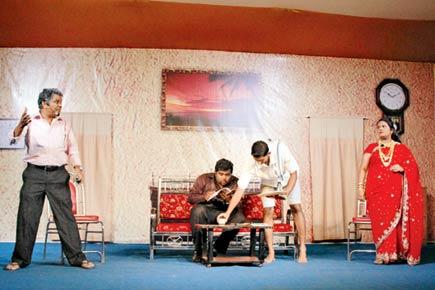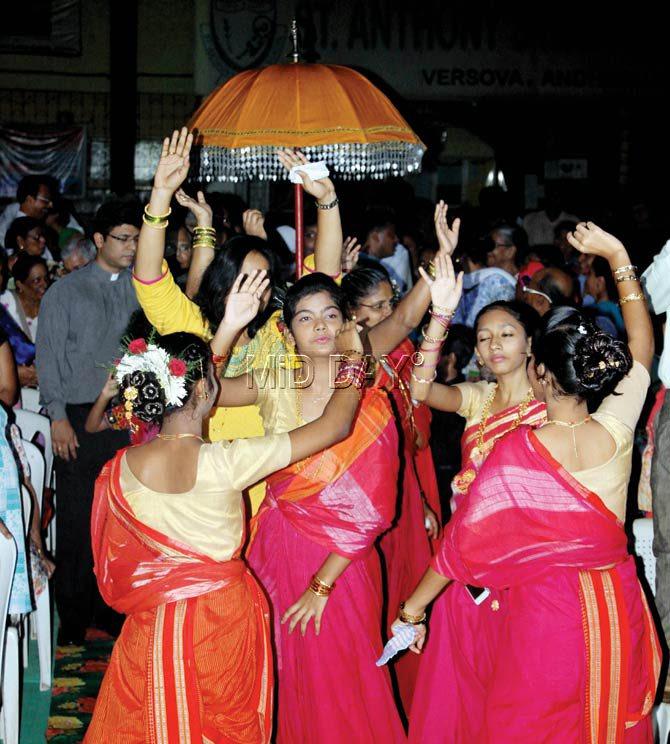A play called Khache Varcha Naach staged by and for the East Indians last week, was a reality check for Mumbai’s oldest residents

Music rent the air, the excitement was palpable. It was certainly not business as usual last Sunday evening at St Antony’s High School Ground in Versova. The venue played host to more than 400 members of Mumbai’s East Indian community who were gathered there to watch Khache Varcha Naach (Dance on the graves).
ADVERTISEMENT

Khache Varcha Naach was performed at St Antony’s High School Grounds in Versova. Pics/Onkar Devlekar
The East Indian production, directed by Sachin Kinny and written by Russel Gonsalves, founders of the R & S Art and Cultural Group, featured artistes making their acting debut, all from Versova’s East Indian families.

The audience rocking the aisles while dancing to the beats of the band
Alphi D'souza, head sarpanch and Mobai Gaothan Panchayat CEO, said, “The play is a mirror to society, and the problems modern East Indians are facing. These concern their hassle with builders eyeing land parcels, and views about the clergy. I support the play and would like to see more performances.”

Evita Gonsalves from Versova village leads the band to the venue
It was evident that the play went beyond entertainment. It was an initiative where actors, the audience and the community as a whole, felt they had a stake. Kinny, who is from Worli gaothan (village), said, “During practise, people came forward to support us, by keeping us nourished with snacks. More than the food though, their presence was encouraging."
Okisa D’mello, a resident of Bhayandar had two reasons, to watch the play. She said, “I brought my husband and children to watch the play as we need to support our people. Not many from our community have got the platform or the opportunity to show their talents. This play fills in the lacunae.”
Kurla’s John Lopes, who came in with his relatives, said, “The Goans have Tiatr (Konkani plays), which they use to disseminate social messages and moral values. After watching the play, I think we, the East Indians, can also can use drama, music and language to celebrate our culture.”
Question of lingo
Percy Buthello from Versova explained, “Today, East Indians are hesitant to speak their mother tongue. There is a difference between East Indian Marathi and Maharashtrian Marathi. Plays like this, help encourage the dialect too.”
Though he is not East Indian, Bertram D’souza, a resident of Versova gaothan, said he spoke fluent East Indian Marathi. The college student who plays the character of Prince in the play, added, “I like East Indian traditions.
I have never felt like an outsider. The community is fun-loving, they have a lot of dance and song in everyday life, too. By using comedy, the play has spread a powerful message to East Indians in particular, and Catholics in general.”
Dressed in a Lugra, the traditional East Indian sari, Evita Gonsalves was one among the dancers. She said, “This play is the voice of our community, couching a message that is social and relevant to our times. It uses comedy as a vehicle to say, we need to support the religious aspects too.”
For Fr. Adrian Ferreira, parish priest of Our Lady of Health Church, Versova, it was about giving people direction. “The play reminds the East Indians about their roots and where they are going, now.”
Fr. Glaston Gonsalves said, “Culture is either just a fashionable topic now, or something to be ridiculed. Many are ashamed to say they are from the community. This play seeks to reverse that trend and instill a sense of pride in them.”
While there were positives, the play also cast a somber note forcing the audience to introspect. Sheron Athaide from Vasai, said, “The play blended humour but the message hit home. I could relate to it at many levels.
What struck me most was that it showed a true picture of the community. Our women love to wear gold; there are intra-community fights and people bad mouth priest and nuns. The play discussed our failings too.”
For Kalina resident, Colin Colaso the play became the canvas for a personal awakening. “I was able to see many of my personal flaws come to light. It was as though my life was being staged.”
Monica Pereira, Bandra resident also had a similar experience. She said, “Property disputes have cleaved so many East Indian families and blinded us. We are not speaking to our relatives because of it. The play was enlightening. I went and danced with a few of my relatives who were also there for the play and made up. It was good to be able to realise my mistakes and meet family again.”
Works both ways
The R & S Art and Cultural Group, just one play old, dream of taking the performance to St Andrew’s Auditorium in Bandra as well as having a show in Uttan, to spread the message of the play to many more East Indians in and around Mumbai.
Like any art form, the play worked because it was entertaining; it held the audience’s attention, forcing them to look at their culture. It mirrored the reality of the East Indian way of life, today. So many performances take the high moral ground, disseminating social messages. Sometimes, though, they fail to hold the audience. This one did both.
 Subscribe today by clicking the link and stay updated with the latest news!" Click here!
Subscribe today by clicking the link and stay updated with the latest news!" Click here!







